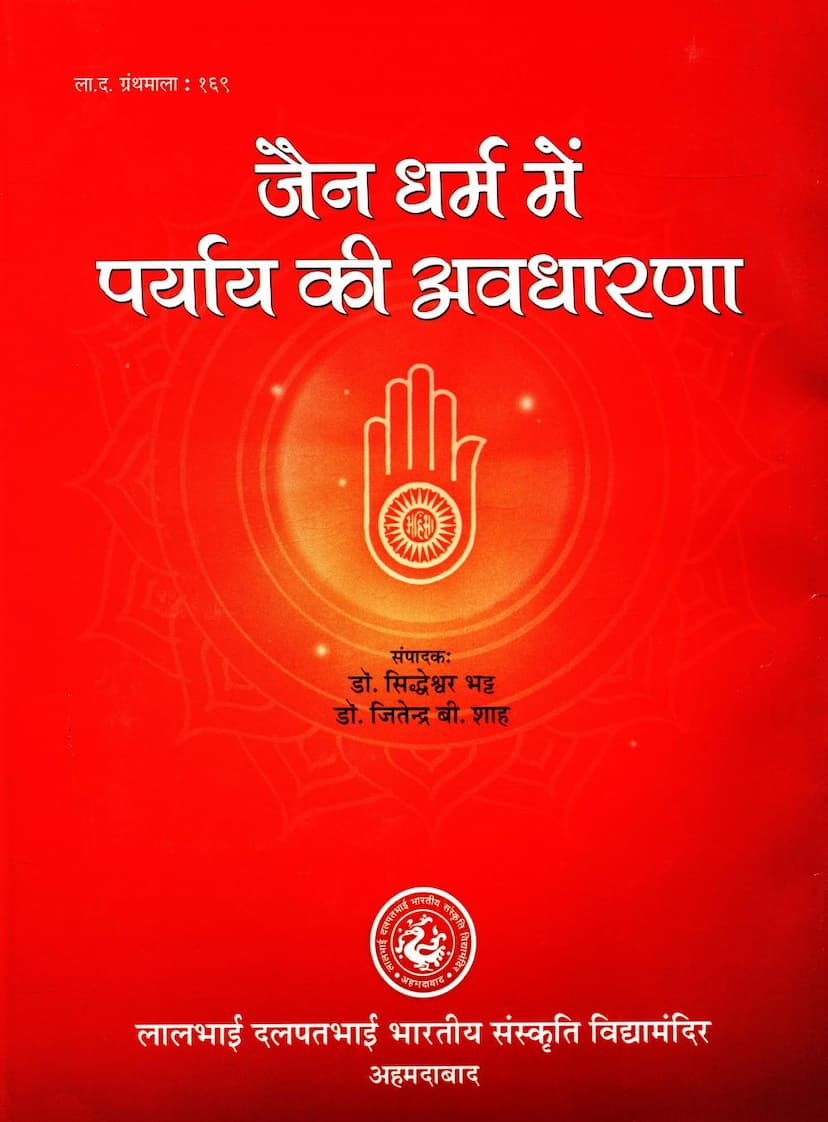Jain Dharm Me Paryaya Ki Avdharna
Added to library: September 2, 2025

Summary
This book, "Jain Dharm mein Paryaya Ki Avadharana" (The Concept of Paryaya in Jainism), published by L.D. Institute of Indology, Ahmedabad, is a compilation of 20 research articles by various scholars, edited by Dr. Siddheshwar Bhatt and Dr. Jitendra B. Shah. The book delves deeply into the Jain philosophical concept of 'Paryaya' (mode, state, modification).
Here's a comprehensive summary based on the provided text:
Core Concept of Paryaya in Jainism:
- Distinction from other Indian Philosophies: While other Indian philosophical traditions have extensively discussed 'Dravya' (substance) and 'Guna' (quality), the specific and unique theory of 'Paryaya' is considered a significant contribution of Jainism.
- Anumetavada and Nayavada Foundation: The concept of Paryaya is presented as foundational to Jainism's central tenet of Anekantavada (non-absolutism) and its associated logical framework, Nayavada (the theory of standpoints).
- Coordination of Permanence and Change: Paryaya acts as a bridge between permanence ('nityata') and change ('parivartan'). It explains how an object or reality undergoes constant transformation while maintaining its underlying substance.
- Product-Vyaya-Dhrouvya: Jain philosophy posits that every reality is characterized by 'Utpad' (origination), 'Vyaya' (destruction/change), and 'Dhrouvya' (permanence). Paryaya is the manifestation of this product-vyaya aspect, while Dravya embodies the dhrouvya.
- Real and Dynamic Existence: Paryaya is not considered illusory but a real and dynamic aspect of existence. It signifies the active principle of reality, making creation and destruction possible.
- Multidimensionality: The principle of Paryaya is multifaceted, influencing not only Anekantavada and Nayavada but also contributing to epistemology (Jnanmimamsa) and axiology (Mulya Mimamsa). It forms the basis for understanding the distinction between Pramana (valid knowledge) and Naya (standpoints), leading to the concepts of Syadvada and Saptabhangi.
Key Contributions and Discussions within the Book:
The book includes articles from various scholars, highlighting different dimensions of Paryaya:
- Achyarya Mahaprajna: Discusses "Naya, Anekant, and the Rules of Thought," emphasizing the coordination of identity (Abheda) and difference (Bheda) to reduce conceptual conflict. He highlights that while senses perceive only parts, Jain Nayas provide different perspectives to understand the whole.
- Siddheshwar Bhatt: Offers a review of Jain philosophical principles, noting their relevance for contemporary humanity facing distress and violence. He emphasizes the harmony between change and permanence.
- Samani Mangal Pragya: Explores the concept of existence in Jainism, defining it as a combination of change and immutability. According to Jain Parinamavada, both Dravya and Paryaya undergo change, yet Dravya retains its core existence.
- Samani Riju Pragya: Discusses the concept of "Bhedabhed" (difference and non-difference) within Dravya-Guna-Paryaya, asserting that there's no fundamental difference but a relational one from the perspective of practical usage and ultimate reality.
- Sagar Mal Jain: Provides a critical overview of the concepts of Dravya, Guna, and Paryaya in Jain philosophy.
- Other Articles: Cover various aspects such as the definition and nature of Paryaya, the concept of pure Paryaya, the philosophical originality of Paryaya, the Bhedabhedavada of Dravya-Guna-Paryaya, the nature of existence, the relationship between Dravya, Guna, and Paryaya referencing texts like 'Sanmati Prakaran', the role of Nayas (Nishchaya and Vyavahara, Rijusutra) in understanding Paryaya, the review of Buddhist concepts of Paryaya, and the application of Jain principles in sadhana (spiritual practice) through 'Mano'nushasan'.
Significance of Paryaya:
- Basis for Anekantavada: The concept of Paryaya allows for the understanding of a reality from multiple perspectives, which is the essence of Anekantavada.
- Reconciliation of Opposites: It harmonizes seemingly contradictory concepts like permanence and change, identity and difference, which is crucial for a comprehensive understanding of reality.
- Contribution to Knowledge and Values: Paryaya influences Jain epistemology and axiology, impacting concepts like Syadvada and the classification of vows (Mahavrata and Anuvrata).
- Potential in Mathematics and Statistics: The book suggests that the principle of Paryaya could offer a qualitative dimension to quantitative fields like mathematics and statistics, a point alluded to by scholars like Professor Mahalanobis and Acharya Mahapragya.
- Understanding Karma and Diversity: The theory of Paryaya aids in comprehending the doctrine of Karma and the diversity of the universe.
- Practical Application: The book stresses the relevance of Jain ethical principles for present-day humanity facing challenges of violence and suffering, advocating for the adoption of Jain principles for peace and prosperity.
- Unique Contribution: The book highlights that while other Indian philosophies discussed Dravya and Guna, it is primarily within Jain Dharma and Philosophy that the specific theory of Paryaya has been meticulously studied.
- First Comprehensive Presentation: The book is presented as the first comprehensive study of the concept of Paryaya in Jainism for the modern academic community, aiming to benefit scholars and thinkers.
Overall Message:
The book aims to present a thorough exploration of the Jain concept of Paryaya, demonstrating its philosophical depth, its role in shaping other Jain doctrines, and its enduring relevance for understanding existence, knowledge, and ethical living. It emphasizes that a proper grasp of Paryaya is essential for comprehending the holistic and nuanced worldview of Jainism, which seeks to reconcile apparent contradictions and offer practical guidance for spiritual development and societal harmony.